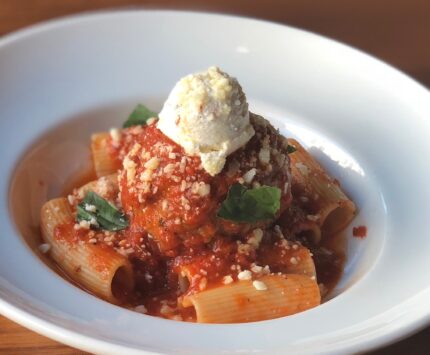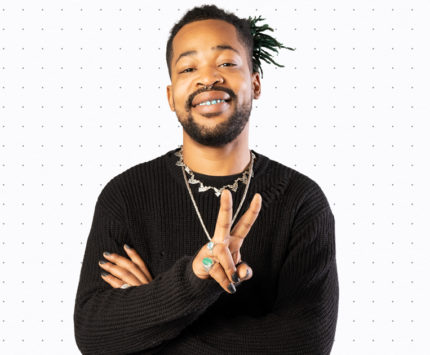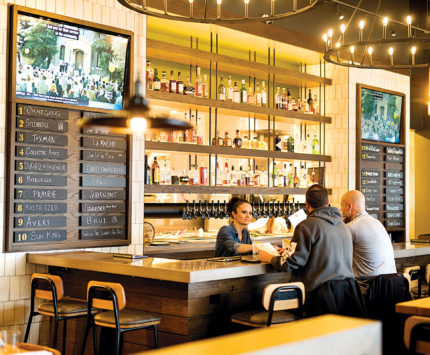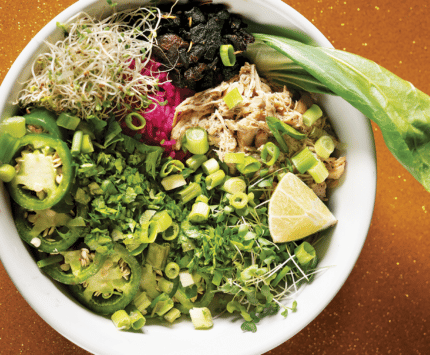Q&A With Nicole-Taylor’s Chef Joe Kalil

Nicole-Taylor’s Pasta Market chef de cuisine Joe Kalil.
After a career that began at the legendary Carriage House in South Bend and included cooking stints in New England, on the Indy and Le Mans racing series, at Woodland Country Club, and, most recently as executive chef of high-volume waterside Rick’s Cafe Boatyard, well-traveled chef Joe Kalil is back working with his friend and mentor Tony Hanslits. He is taking on some of the wildly popular private dinners and helping to expand the retail offerings at SoBro gourmet shop Nicole-Taylor’s Pasta Market. And while he’s still working hard and learning new techniques, the more relaxed pace of the retail store allows him time to reflect on the wisdom he’s gained from his decades in the culinary world, as well as how he’s still learning and growing as a chef.
You got your start at South Bend’s Carriage House (now The Carriage House Dining Room & Garden), which was surprisingly cutting-edge for its time. How did you land a job there?
I was already working as a dishwasher at another restaurant, the Louvered Door, just to make extra cash to buy a car. I didn’t really know what I wanted to do with my life, but I was almost a junior, and it was time to start planning for my future. Then one day there was a career fair at my high school, and Peter George (the longtime local restaurateur and real estate agent) himself was there representing his mother’s restaurant, The Carriage House. He said that I should come consider working there. A few months passed, and I went into the restaurant to get a gift card, and Peter remembered me. I came in a few weeks later. Tony [Hanslits] was actually the chef there. This was before there was anything really new or interesting going on, foodwise, even in Indy. But Hanslits and George were making everything fresh and getting local stuff, before it was trendy or “farm to table.” It was a great place to get introduced to the industry.
Food was definitely something you already had a love for?
I’m half Polish and half Lebanese, so food was definitely a big part of my upbringing. Like a lot of folks from South Bend, we made tons of pierogi, mostly just cheese and green onion but sometimes some with sauerkraut. But food was mostly just something I was around a lot, not something I did. I would watch my Lebanese grandmother perched on a chair making Middle Eastern breads and kibbeh, as well as stuffed grape leaves and baklava. She always had to get this special kind of cracked wheat from nearby in Michigan, which was just the right grind. I wish I had learned more of her recipes or written more of them down.
Soon after that, you went off to culinary school at Johnson & Wales in Rhode Island. You already had some pretty thorough experience, so was that essential to your career?
I stayed on for a year after high school before going off to culinary school in New England. Tony actually left for a job in Ohio, and Peter was on his way to Indy to open the original Peter’s in Fountain Square. I don’t think culinary degrees are essential, but they look good on a resume, and any experience is good. But Tony had already shown me so many things in a thorough and unhurried way that I breezed through the first year at Johnson & Wales. I had already been fileting salmon for months while the other students were doing it for the first time. Going East did get me a job at Cafe in the Barn just over the border in Massachusetts, which was a setup a bit like at Nicole-Taylor’s with a retail counter in front. This was my first experience with catering, and we did the catering for a performance of The Nutcracker Suite in Boston, which was great. This really gave me some experience for a lot of the food service and hotel work I would later do.
Eventually you did a stint as a corporate chef for hospitality groups on various Indy and NASCAR racing series. How was that different from restaurant work?
I was traveling from as far as Portland to Detroit between races, so it really helped me understand regional foods and what I could source in different parts of the country. It all started when I was working at the Indianapolis Motor Speedway Motel (later the Brickyard Crossing Golf Resort and Inn). This was the first year of NASCAR. I was at the track talking to a regular customer who was starting a hospitality service for Dan Gurney’s racing team. This was definitely a change of pace, as we were doing buffets for the racers and team, as well as taking two to three meals a day to the crews working on the cars. The drivers had all sorts of dietary needs such as high-carb, low-salt diets with lots of protein. I was making a lot of pasta. One driver wanted certain brands that I had to source and keep with us. But traveling so much with the teams meant that I would know which other team chefs to split orders with or where there were farmers markets and places to get certain ingredients. For instance, when we were in Vancouver, we’d do a seafood-heavy menu. It was a great education because, as a chef, you want to keep informed about regional and local foods and how to adapt your cooking to them.
After you came back to Indy, you worked for nearly 12 years at Woodland Country Club and then several years at Rick’s Cafe Boatyard on Eagle Creek Reservoir. Why did you make the change, and what’s it like to be back working with Tony Hanslits?
At the country club and especially at Rick’s, I wasn’t on the line all that much. I was making sure we had all the product and putting out fires. The pandemic was especially challenging, as we had to scale back our menu at Rick’s to about half of what we normally had. The availability of seafood was especially tough. I would put in an order for 300 pounds of catfish (we used to order almost 1,000 pounds), and I’d get 75. I had one source that would call me now and then, and I’d take all they had. Large sea scallops became prohibitive, and I couldn’t charge customers enough to recoup my costs. So that was taking its toll. I’ve always been in touch with Tony and Rosa [Rosa Rulli Hanslits], and they were wanting to grow Nicole-Taylor’s. They feature private dinners that sell out for a whole year in just three days. They brought me in both to help with the retail operation but also to take some of the meals off of Tony’s hands. Unlike my jobs in the past, it’s pretty much free rein. It’s like having people come over to your house. I’m on my homefield.
What have you brought to the dinners, and what are some of the challenges of cooking live in front of an audience?
Tony hates doing desserts, so I’ve made the desserts for some of his meals and the market as well, a fig and pear tart or a flourless chocolate cake with Calabrian chilies. I make a Frangelico semifreddo as well. People are so much more knowledgeable about food things, and it’s fun nailing down what they want in advance but then having some freedom to do what I want the nights of the dinners. But it can be a little harrowing at times. At one of the dinners, I had a sauté pan I’d had in the oven, and I grabbed the handle with my bare hand. Then the pan started to fall, so I had to grab it again. I had to save my sauce. The diners were amazed that I could do that, and it’s become a bit of a running joke now.
What advice would you give to a young person starting out in the restaurant world?
I’d tell them to find a place that makes scratch food and just dive in. Put your whole heart into it. It helps to find a good mentor as well. When I was starting out, Tony actually tried to talk me out of it for the first two months, telling me that the work was grueling, that chefs were prone to all sorts of personal problems and relationship issues. But he was just letting me know what I was getting myself into. He told me that if I was really serious about it, that I should do it the right way, and he showed me everything. I’d tell a younger person that if at the end of the day, they still like it, that they should go for it. It doesn’t matter really about how much experience you have as long as you have a passion for it.





